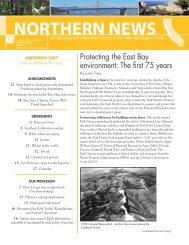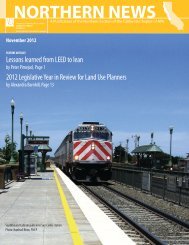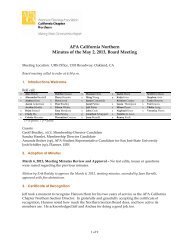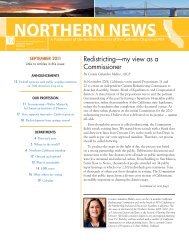Layout 1 - Northern California Chapter of the American Planning ...
Layout 1 - Northern California Chapter of the American Planning ...
Layout 1 - Northern California Chapter of the American Planning ...
You also want an ePaper? Increase the reach of your titles
YUMPU automatically turns print PDFs into web optimized ePapers that Google loves.
BOOK REVIEWReshaping Metropolitan America: DevelopmentTrends and Opportunities to 2030By Dr. Arthur C. Nelson, FAICPReviewed by Dr. Donald Bradley, AICPIn his new book, Pr<strong>of</strong>essor Arthur Nelson says <strong>the</strong> segregation <strong>of</strong>land uses, once <strong>the</strong> mainstay <strong>of</strong> zoning practices, has given way tomixed-use development as <strong>the</strong> preferred scenario <strong>of</strong> <strong>the</strong> long-rangeregional plans in <strong>the</strong> 21st century. He suggests several incrementaldevices to make our cities healthier, more livable, and sustainable.He displays research data in over two dozen tables in this fact-filledbut thin paperback.Nelson systematically leads us through <strong>the</strong> changing trends <strong>of</strong> cityand regional planning from <strong>the</strong> race to <strong>the</strong> suburbs <strong>of</strong> <strong>the</strong> 50s, tractsubdivisions <strong>of</strong> <strong>the</strong> 60s, planned unit developments <strong>of</strong> <strong>the</strong> 80s,through cluster housing and condominiums, <strong>the</strong> “new urbanism,”transit and pedestrian oriented development, planned retirementcommunities, and exurban, urban, and rural sprawl.The author argues that we must radically revise our thinking andplanning based on each <strong>of</strong> <strong>the</strong> several generations’ preferences (e.g.,Eisenhowers, Baby Boomers, Generations X and Y). The Millennialsprefer living closer to <strong>the</strong> core central business districts, transitvillages, or along commercial corridors to have options for livingand working without long single-occupancy automobile commutingto work. They prefer (or at least say <strong>the</strong>y prefer) walking, bicycling,or using public transit (like light rail or express buses); small lots,less yard work, more neighborhood parks; higher populationdensities; and scaled down residences instead <strong>of</strong> “McMansions.”The book cites several studies which all seem to agree that ourbest strategy to meet our housing goals over <strong>the</strong> next two decadeswould be to build infill and redevelopment projects on existingoutmoded homes. Nelson dutifully provides statistics from nearly100 online sources. These include HUD, US Census, NAHB,Pew Research, Washington Post, The New York Times, BloombergMarkets, Huffington Post, USDOT, The Wall Street Journal, ULI,Smart Growth America, <strong>the</strong> Brookings Institution, <strong>the</strong> FederalReserve Board, <strong>the</strong> Harvard Joint Center for Housing Studies,Resources for <strong>the</strong> Future, APA, The National Academy <strong>of</strong> Sciences,<strong>the</strong> UN, Bureau <strong>of</strong> Economic Analysis, Woods & Poole Economics,Bureau <strong>of</strong> Labor Statistics, and EPA.Nelson cites <strong>the</strong> shifts over time in new residential constructionin <strong>the</strong> 50 largest U.S. metropolitan regions. Here, for example, ishow <strong>the</strong> infill and redevelopment share <strong>of</strong> new units has increasedin <strong>the</strong>se metropolitan areas:• New York City, from 15 to 63 percent,• Chicago, from 7 to 45 percent,• Portland, from 9 to 38 percent,(continued on page 16)<strong>Nor<strong>the</strong>rn</strong> News 7 May 2013





![[NAME OF EVENT] EVALUATION FORM](https://img.yumpu.com/32351925/1/190x245/name-of-event-evaluation-form.jpg?quality=85)

